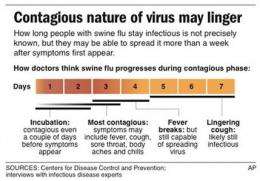Studies: Swine flu spreads long after fever stops (Update)

(AP) -- When the coughing stops is probably a better sign of when a swine flu patient is no longer contagious, experts said after seeing new research that suggests the virus can still spread many days after a fever goes away.
The federal Centers for Disease Control and Prevention has been telling people to stay home from work and school and avoid contact with others until a day after their fever breaks. The new research suggests they may need to be careful for longer - especially at home where the risk of spreading the germ is highest.
Swine flu also appears to be contagious longer than ordinary seasonal flu, several experts said.
"This study shows you're not contagious for a day or two. You're probably contagious for about a week," said Gaston De Serres, a scientist at the Institute of Public Health in Quebec.
He presented one of the studies Monday at an American Society for Microbiology conference. It is the first big meeting of infectious disease experts since last spring's emergence of swine flu, which now accounts for nearly all of the flu cases in the United States. More than 1 million Americans have been infected and nearly 600 have died from it, the CDC estimates.
It is unclear whether the new research will lead the CDC to rethink its advice on how long people with swine flu should hole up. Long breaks from school and work do not seem worth it for a virus that now seems to cause mostly mild illness, said the CDC's flu chief, Nancy Cox. Swine flu is spreading so widely now that confining the sick does less good, she said.
"We tried to have our guidance balance out all of these factors," she said. "It's just virtually impossible not to have virus introduced into settings such as schools and universities."
Doctors know that people can spread ordinary seasonal flu for a couple of days before and after symptoms start by studying virus that patients shed in mucus. The first such studies of swine flu are just coming out now, and they imply a longer contagious period for the novel bug.
"It's probably realistic that this virus sheds much longer than seasonal flu," said Dr. Jonathan McCullers, an infectious diseases specialist at St. Jude Children's Research Hospital in Memphis, Tenn.
Three reports suggest this is so. De Serres and other researchers in Canada took nose and throat swabs from 43 patients with lab-confirmed flu and dozens of other sick family members.
On the eighth day after symptoms first appeared, 19 to 75 percent showed signs of virus remaining in their noses, depending on the type of test used.
"This proportion appears to be very big, and it is," but it's not clear how much virus is needed to actually spread flu, so the lower number is more reliable, he said.
Dr. David C. Lye reported on 70 patients treated at Tan Tock Seng Hospital in Singapore. Using a very sensitive test to detect virus in the nose or throat, he found that 80 percent had it five days after symptoms began, and 40 percent seven days after. Some still harbored virus as long as 16 days later. How soon they started on antiviral medicines such as Tamiflu made a difference in how much virus was found, but not whether virus was present at all.
A third report came from Dr. Guillermo Ruiz-Palacios of the National Institutes of Medical Science and Nutrition in Mexico, where the first cases of swine flu were detected.
Infected people "shed the virus for a very, very long time," often for more than a week after the start of symptoms, he told the conference. This was especially true of obese people, and patients who started on medicines longer than two days after symptoms first appeared.
The new reports suggest a longer contagious period for swine flu, but how long is not clear, Cox said. Even with it in your nose, "you might not be shedding enough virus to infect other people," she said.
That is why signs like coughing may matter more, De Serres said.
"Contagiousness varies, not only with the presence of the virus, but the other symptoms that would make you transmit," he said.
Swine flu symptoms can include fever, cough, sore throat, runny or stuffy nose, body aches, headache, chills and fatigue, and sometimes diarrhea and vomiting. Young children may be cranky, less playful or not eat as much as normal, the CDC advises.
The agency's advice to stay home for a day after fever breaks does not apply to health care settings. There, confinement for seven days from the start of symptoms - or until they go away, whichever is longer - is still advised.
People who have had swine flu should cover their mouths when they cough or sneeze and wash their hands a lot once they do return to work and school, the CDC says.
---
On the Net:
Swine flu info: http://www.flu.gov
CDC advice: http://www.cdc.gov/h1n1flu/guidance/exclusion.htm and http://www.cdc.gov/h1n1flu/qa.htm
Medical conference: http://www.icaac.org
©2009 The Associated Press. All rights reserved. This material may not be published, broadcast, rewritten or redistributed.

















